Key takeaways:
- Classic cars evoke nostalgia and represent a connection to automotive history, sparking interest in restoration and preservation.
- Restoring vintage cars fosters a bond between the restorer and the car, highlighting the importance of craftsmanship and community engagement.
- Proper tools and a well-planned approach are essential for successful car restoration projects, emphasizing the need for patience and attention to detail.
- Common issues like electrical problems, rust, and engine performance require knowledge and persistence to resolve, contributing to the overall satisfaction of the restoration journey.
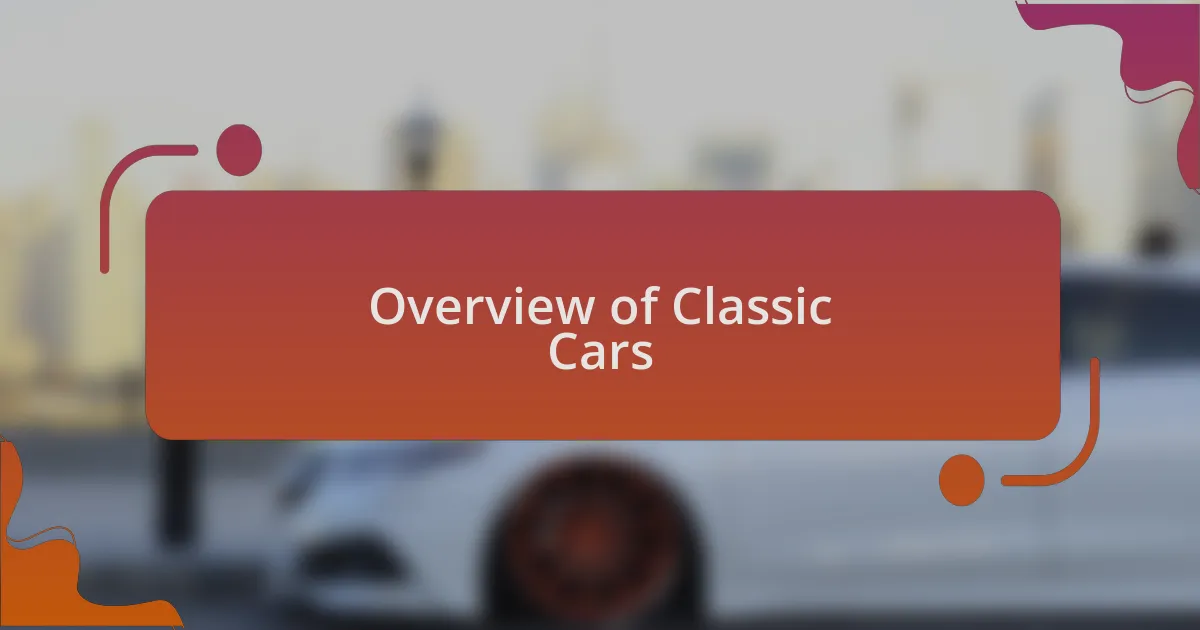
Overview of Classic Cars
Classic cars hold a certain magic, don’t they? For me, each model tells a story, showcasing the craftsmanship and innovation of its era. I remember the first time I encountered a 1967 Mustang; it was like stepping into a time capsule, with every curve and detail echoing the past.
The allure of classic cars lies not just in their aesthetics but also in the memories they evoke. I often find myself reminiscing about my grandfather’s old Chevrolet, which he lovingly referred to as “Old Reliable.” It was more than just a car; it was a vessel of family trips and laughter, and it sparked my desire to learn about restoration and preservation.
There’s something incredibly satisfying about working with your hands to restore an iconic vehicle. I still feel the rush when I hold a wrench, ready to make a difference. Isn’t it fascinating how, with a bit of time and effort, these vintage machines can be brought back to life, allowing us to experience a slice of automotive history firsthand?
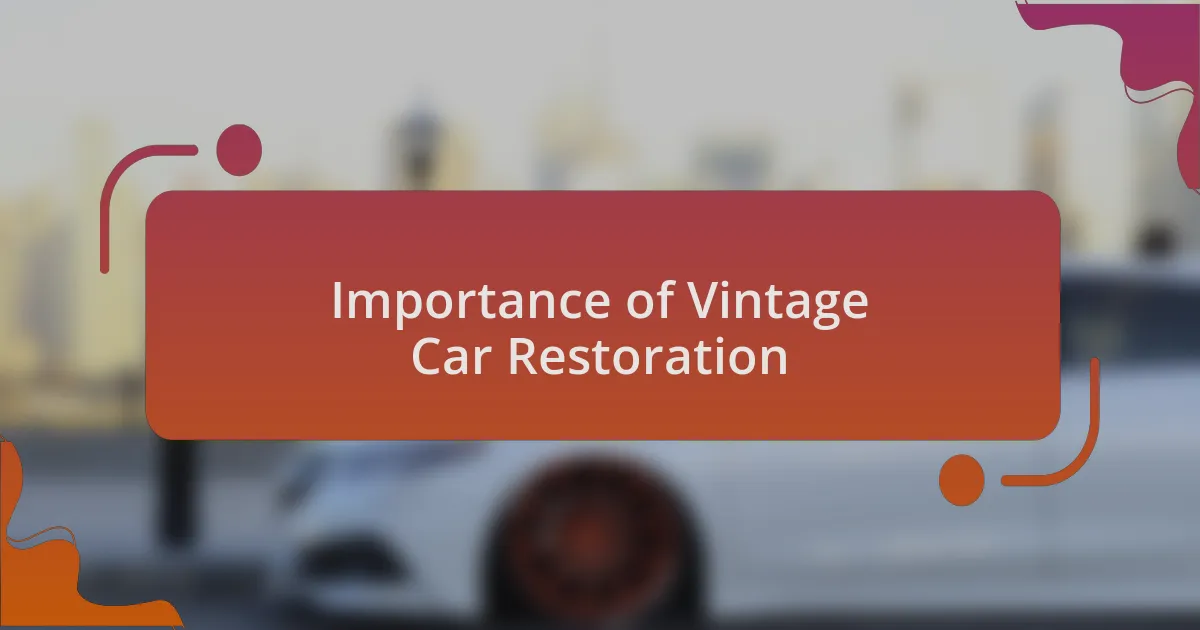
Importance of Vintage Car Restoration
Restoring vintage cars is more than just a hobby; it plays a crucial role in preserving automotive history. Each restoration project helps maintain the story of an era, reminding us of the ingenuity that went into every design. I remember the thrill of uncovering parts in my garage that hadn’t seen the light of day in decades. Those moments were like unearthing hidden treasures, bridging generations as I learned about the engineering behind those beautiful machines.
The process of restoration fosters a unique bond between the car and the restorer. I often find myself immersed in the details, not just of the vehicle’s mechanics but also its heritage. Each dent, scratch, and rust patch tells a story of its travels. What better way to honor that legacy than by reviving it? I find that these cars represent more than metal and rubber; they symbolize dreams and aspirations that many had during their time.
Moreover, vintage car restoration provides an avenue for community engagement and learning. By sharing my experiences with others who share the same passion, I’ve built friendships that stretch beyond just mechanics. Isn’t it rewarding to see a group of enthusiasts come together, exchanging tips and stories? The camaraderie that springs from restoring these cars enriches our collective understanding of automotive passion, inspiring new generations to appreciate and continue this important craft.
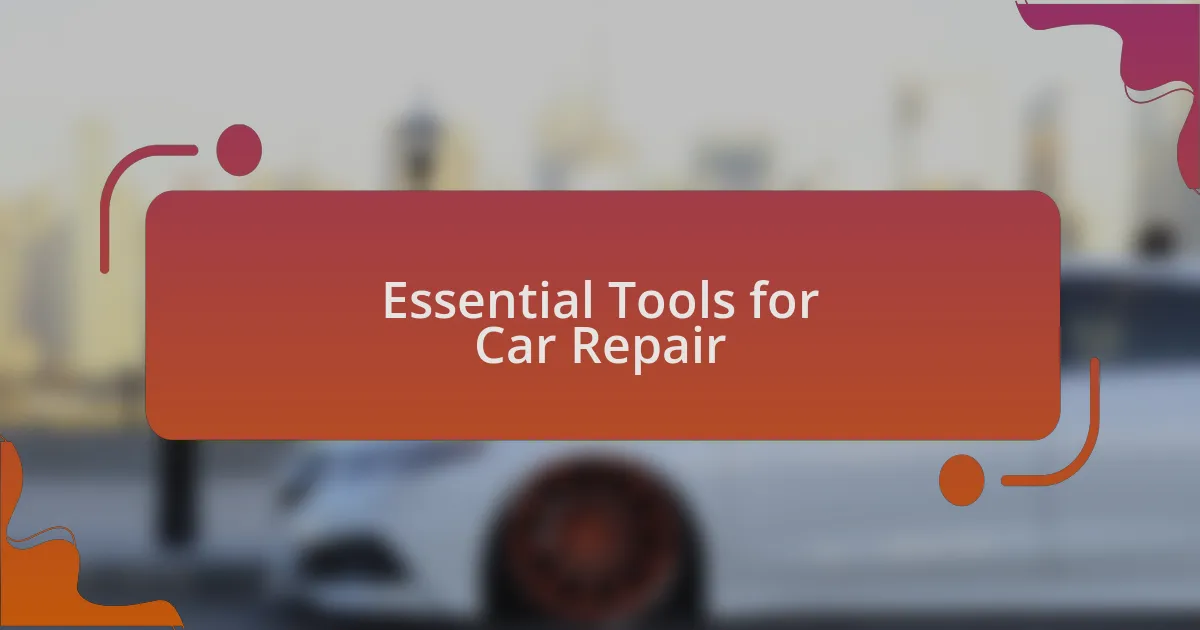
Essential Tools for Car Repair
When it comes to fixing classic cars, having the right tools is non-negotiable. A quality socket set often becomes my best friend in the garage. I remember the first time I tackled an engine overhaul; it was these sockets that saved me hours, making tight spaces less intimidating. Without them, I’d still be wrestling with rusty bolts!
Beyond the basic hand tools, specialty items make a world of difference. For instance, a torque wrench allows for precise tightening, crucial for old engines. I learned the hard way that under-tightening can lead to leaks, so investing in reliable tools taught me the value of accuracy. Have you ever taken a step back and realized just how much respect vintage cars demand? Every tool reflects that respect.
Don’t overlook the importance of a sturdy workbench and proper lighting, either. I can’t count the number of evenings I spent squinting under dim bulbs. Now, with my well-lit workspace, I can inspect every detail, transforming a simple repair into a thorough evaluation. It’s amazing how a comfortable environment enhances the whole experience, don’t you think?
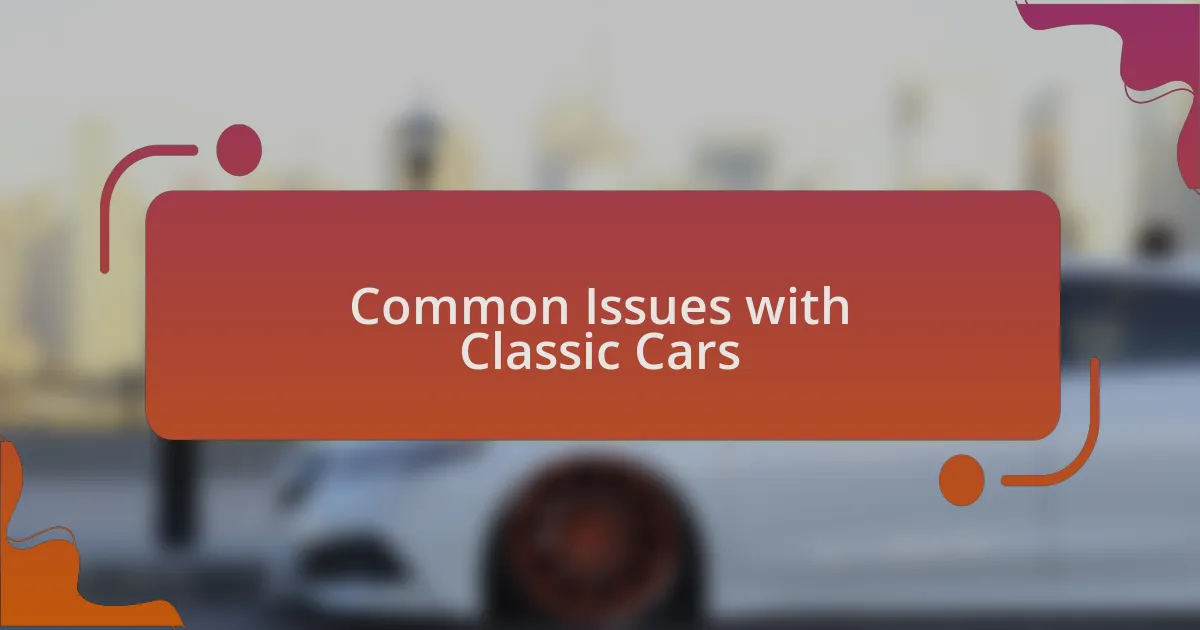
Common Issues with Classic Cars
When it comes to common issues with classic cars, one of the first culprits I often encounter is electrical problems. Wiring in older models can be a real mystery; I remember tracing through a spaghetti of connections to find a simple short. It’s frustrating, but the satisfaction of solving an electrical glitch is a feeling like no other. Have you ever had to decipher a puzzle that seemed impossible until all the pieces clicked into place?
Another frequent challenge is rust and corrosion. I once bought a classic that looked gorgeous from afar but, up close, revealed hidden patches of rust. It took hours of sanding and treatment to get it right. This experience taught me that appearances can be deceiving, and it’s essential to inspect every nook and cranny before committing to a project. Isn’t it fascinating how sometimes the best stories are hidden beneath the surface?
Additionally, engine performance can be a persistent issue in vintage vehicles. I recall battling with carburetor adjustments for what felt like an eternity. Each tweaking session required patience and intuition, but ultimately, feeling that engine purr after all the effort made it worthwhile. Has there been a moment when you’ve struggled but felt an overwhelming rush of accomplishment when everything finally came together?
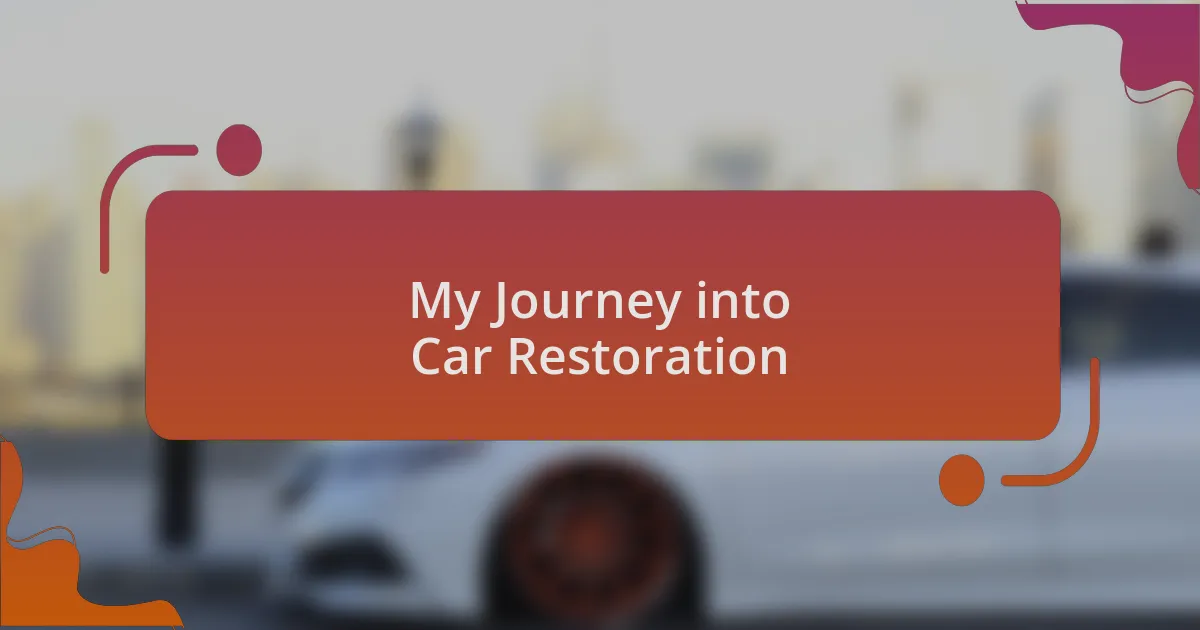
My Journey into Car Restoration
My journey into car restoration began with a rusty old Mustang that sat in my neighbor’s yard. I had always admired its sleek lines and vintage charm, but when I finally had the chance to take it home, I quickly realized the extent of the work needed. The thrill of breathing life into that neglected beauty was daunting yet exhilarating; do you remember your first big project that felt both terrifying and thrilling?
As I dove deeper into restoration, I discovered the importance of community. I joined online forums and local clubs, where seasoned enthusiasts shared their wisdom and troubleshooting tips. I still recall a late-night discussion about bodywork techniques that not only fixed my dented fender but also forged lasting friendships. Isn’t it wonderful how sharing a passion can turn strangers into friends?
One of my proudest moments came when I managed to revive a forgotten engine after weeks of trial and error. The first roar of that engine was nothing short of music to my ears. It felt like a personal victory, a reminder that perseverance pays off, even in the face of adversity. Have you experienced a moment in your journey where hard work transformed your dreams into reality?
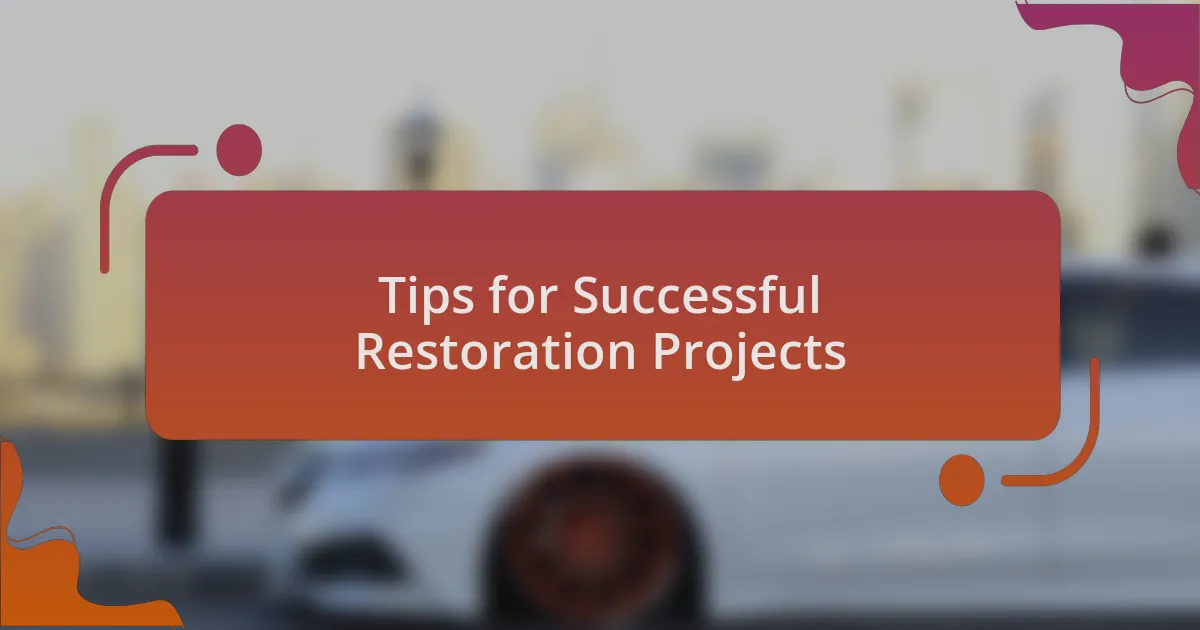
Tips for Successful Restoration Projects
When embarking on a restoration project, creating a detailed plan can be a game changer. I remember diving into my first project without a clear direction, which left me overwhelmed amid countless tasks. Now, I always take the time to outline each step, from sourcing parts to budgeting time and resources. How do you approach planning in your projects?
Patience is another essential ingredient in successful restorations. I vividly recall the hours spent meticulously sanding down layers of old paint on my Camaro—each stroke felt almost meditative. In moments of frustration, I had to remind myself that progress takes time; sometimes, the smallest steps lead to the most significant results. Have you ever found that taking a break could yield a fresher perspective?
Lastly, don’t overlook the importance of documentation. I’ve kept a photo log of every phase—from the initial disassembly to the final polish. Looking back at those images not only tracks my progress but also reveals the lessons learned along the way. It’s a rewarding reminder of how far I’ve come; what would it mean for you to see your restoration journey documented?